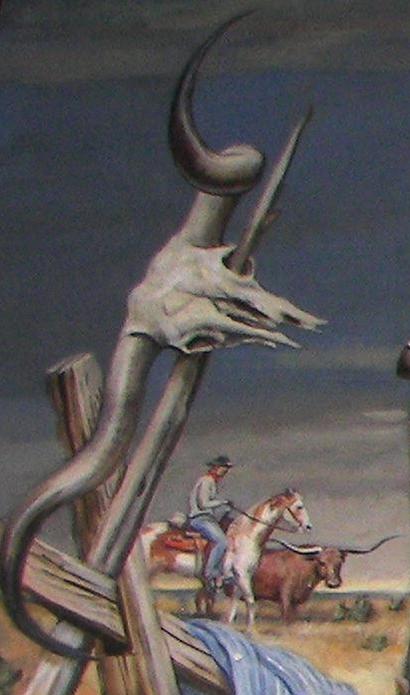|
|
After
the Civil War, Texas and the rest of
the South were in a bad economic situation. The war had drained the
resources of the defeated states and when the soldiers returned home,
they found it extremely hard to make a living. But Texas
had an untapped resource roaming wild on the open range – longhorn
cattle provided an industry that grew to become the largest in
the state.
Lavaca County became
a major cattle producer along with the rest of Texas.
In his book, History of Lavaca County, Paul C. Boethel writes
that the open range and the low-priced land in the county quickly
attracted cattlemen to the area. By 1870, cattle in Lavaca
County numbered 56,309. Prominent cattlemen at the time were Lew
B. Allen, W.J. Moore, J.M. Bennett, Sel West, Ike West, George West,
Bill Gentry, and Willis McCutcheon.
Well-known cattleman, “Shanghai”
Pierce is believed to have put together a herd of mavericks in
Lavaca County. Cowboys
working for Pierce
rode the area around Big Sandy searching for “wild brush cattle.”
That part of the county was thinly settled and was know for having
large numbers of strays. The animals were very wild and would lie
up in the brush during the day, coming out at night to graze. Pierce’s
men would wait until early morning to begin rounding them up. A good
month’s work would usually be about 1,100 head. |
 |
Cattle
from Lavaca County
were driven up the trail to Kansas markets in Abilene, Dodge City,
and other towns as well. From the end of the Civil War in 1865 until
1885, large herds of cattle were sent up the trail. The trek from
Lavaca County started
at the small settlement of Bovine, on Brushy Creek, and then moved
west passing by Peach Creek and Gonzales.
The path led on to Austin
and from there to the old Chisholm Trail, eventually to end in Kansas.
According to the History of Lavaca County, in 1870, it took
A.E. Schiske 64 days to drive a herd of 1,000 head up the trail to
Abilene, Kansas. In 1874, cattlemen Leo Tucker, John May, and Joel
Bennett drove 3,000 cattle to Abilene. These are only a couple of
known drives; many other smaller herds were taken to market, but no
records exist as to who drove them or the number of cattle involved.
After the open ranges were fenced, the cattle industry began to slump,
only to revive again and by 1900, records indicate that the number
of cattle in Lavaca
County exceeded 60,000.
The history of the old cattle drives seem like scenes from movies
such as “Lonesome Dove” or “Red River” – but the real cowboy’s job
was far from glamorous – the work was monotonous and included long
days in the saddle. These were the men who had just fought a long
and bloody war, hard-working cowboys who did what they had to do in
order to survive. And in the process they brought Texas
out of a depression into economic wealth.
© Murray Montgomery
Lone
Star Diary July
10, 2009 Column |
|
|
